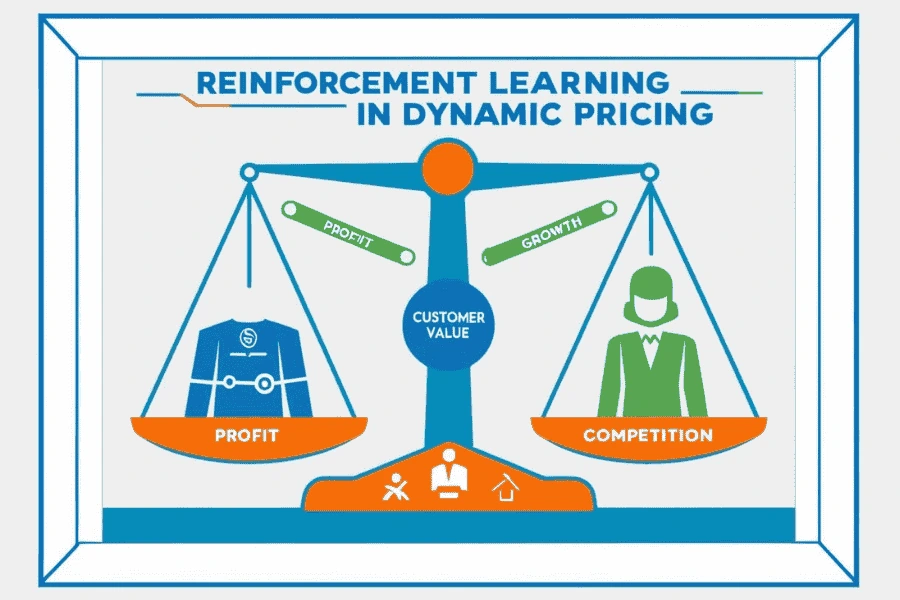Reinforcement Learning in Dynamic Pricing: Balancing Profit, Competition, and Customer Value
Introduction
In today’s rapidly evolving markets, dynamic pricing has become a vital strategy for businesses aiming to optimize revenue. Static pricing approaches are often insufficient as they cannot adapt quickly to changing customer demand, competitor prices, or market conditions. Reinforcement learning (RL), a cutting-edge branch of artificial intelligence (AI), offers dynamic pricing solutions that continuously learn and adapt pricing decisions. By leveraging AI-powered pricing strategies and advanced machine learning techniques, companies can optimize profits while maintaining competitiveness and maximizing long-term customer value.

The Role of Reinforcement Learning in Dynamic Pricing
Reinforcement learning is well-suited to dynamic pricing because it treats pricing as a sequence of decisions influenced by the evolving market environment. Through constant interaction, RL models develop adaptive pricing policies that consider immediate revenue goals alongside long-term customer satisfaction. These AI-based price adjustment mechanisms use data on competitor pricing, demand forecasting with machine learning, and customer segmentation to generate personalized pricing algorithms that increase customer lifetime value (CLV). Techniques such as deep Q-networks and policy gradient methods have proven effective in solving complex dynamic pricing problems.
Core Elements of RL-Driven Pricing Systems
An RL pricing framework requires defining the state space to include relevant market information such as customer profiles, competitor prices, demand elasticity, and stock levels. Actions correspond to possible pricing decisions or real-time price adjustments. The reward function is designed not only to capture immediate profits but also to reflect goals like customer retention and overall revenue management with AI. In competitive markets, multi-agent reinforcement learning models can simulate interactions between multiple sellers, enabling the discovery of dynamic equilibrium pricing strategies.
Harmonizing Profit, Market Competition, and Customer Focus
Dynamic pricing software powered by RL enables firms across sectors like e-commerce, retail, airlines, and subscription-based services to optimize pricing in real-time. Competitive pricing strategies utilizing machine learning ensure firms respond effectively to competitor moves while maximizing their margins. Incorporating adaptive pricing models that emphasize customer lifetime value fosters loyalty and sustainable growth. AI price optimization tools facilitate continuous price updates informed by demand forecasting and competitor pricing analysis, improving revenues without eroding customer trust.
Popular Algorithms and Techniques
Deep Q-Networks (DQN) are commonly used for discrete pricing levels, while policy gradient and actor-critic methods suit continuous price optimization. These machine learning pricing models provide nuanced control over pricing policies. Industries with subscription services benefit by optimizing pricing to reduce churn and increase renewals. Ride-sharing platforms employ real-time pricing algorithms and surge pricing models to balance supply and demand dynamically. Understanding price elasticity through modeling further refines pricing effectiveness.
Challenges in Applying RL for Dynamic Pricing
Despite the benefits, RL-based dynamic pricing faces several challenges. Balancing exploration and exploitation is crucial; the agent must try new pricing strategies to discover optimal solutions without losing revenue. Complex, high-dimensional data and fluctuating market conditions increase difficulty in training robust models. Additionally, delayed reward feedback such as the effect of pricing on customer loyalty complicates reward design. Ethical considerations, including fairness and avoiding discriminatory pricing, are important. Continuous monitoring and retraining ensure sustained model performance.
Industry Applications
Numerous sectors have integrated reinforcement learning and machine learning pricing models into their dynamic pricing approaches. Airlines use AI for real-time fare optimization based on seat availability and competition. Hotels implement machine learning in revenue management to adjust room rates for maximum occupancy and profit. E-commerce retailers apply dynamic pricing with AI to tailor prices to individual customers, boosting conversion rates. Ride-sharing companies leverage surge pricing algorithms powered by real-time data to maintain equilibrium between demand and supply.
Future advancements
Future advancements aim to combine reinforcement learning pricing case studies with causal inference to better interpret the impact of pricing decisions. Transfer learning can accelerate adaptation of models across products or markets. Emphasis on ethical AI and pricing fairness will grow to ensure transparency and consumer trust. The development of AI price optimization tools and sophisticated dynamic pricing software will further democratize access to these advanced strategies.
Conclusion
Reinforcement learning has transformed dynamic pricing by enabling intelligent, adaptive, and flexible pricing strategies that balance profitability, competition, and customer satisfaction. Integrating AI-powered pricing strategies and machine learning pricing models allows businesses to navigate complex market dynamics effectively. While challenges like exploration-exploitation balance and reward design persist, ongoing innovation in RL algorithms and pricing technology positions reinforcement learning as a key driver of modern dynamic pricing solutions.
Active Events
Best Tips to Create a Job-Ready Data Science Portfolio
Date: Aug 06, 2025 | 7:00 PM(IST)
7:00 PM(IST) - 8:10 PM(IST)
2811 people have registered
Transition from Non-Data Science to Data Science Roles
Date: Aug 07, 2025 | 7:00 PM (IST)
7:00 PM (IST) - 8:10 PM (IST)
2753 people have registered
Bootcamps
Data Science Bootcamp
- Duration:8 weeks
- Start Date:October 5, 2024
Full Stack Software Development Bootcamp
- Duration:8 weeks
- Start Date:October 5, 2024
